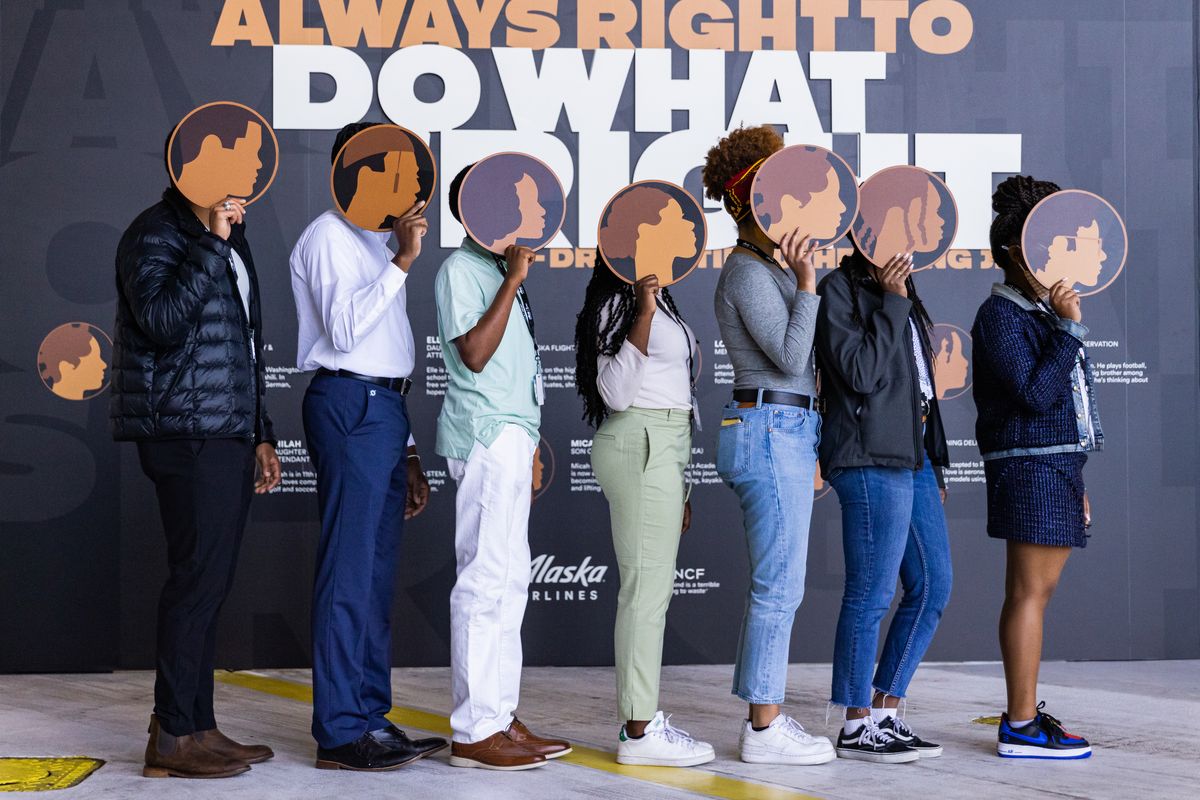‘Her image is an inspiration’: Whitworth student depicted on new Alaska Airlines aircraft

If people didn’t look up to Alexis Dubreuil before, they do now.
Dubreuil, a 20-year-old sophomore at Whitworth University, is among a group of students whose faces appear on one of the newest commercial airliners in the Alaska Airlines fleet.
Called “Our Commitment,” the custom Boeing 737-900 ER represents what Alaska Airlines calls its belief in the importance of education and dedication to the company’s diversity, equity and inclusion goals announced earlier this year. Our Commitment was announced in conjunction with the United Negro College Fund, with which Alaska Airlines has partnered for 15 years.
Our Commitment displays the likenesses of Dubreuil and 13 other students alongside quotes from Martin Luther King Jr. and Nelson Mandela. The group also includes students from Washington State University and the University of Washington.
The aircraft will fly in Alaska’s fleet for up to 10 years.
“Representation is so important,” said Dubreuil, who is double majoring in international studies and French. “Yes, it’s me, but if you don’t know who I am, then it could be anybody. It’s just silhouettes. Seeing a plane in the sky and seeing yourself being represented by a student who is in higher education, who is ambitious, that is so important to see successful people that look like you.”
The concept emerged from concerns Alaska Airlines employees expressed around the time of George Floyd’s death last year, said John-Antony Dubreuil, Alexis’ father and a senior test manager for Alaska Airlines information technology services.
John-Antony, a leadership adviser for Alaska’s Black Employees, Allies and Advocates (ABEA) group, said the concerns initially circulated internally through virtual channels given during the COVID-19 lockdown. According to Alaska Airlines, racial diversity among the company’s frontline workers is more than 30% compared to just 16% at leadership levels.
ABEA then brought these issues to upper management.
“They listened, they saw the employees and they realized, just like a lot of the country, that they had a different reality than some of our employees did,” John-Antony said. He added, “As ABEA, we pushed our leaders to be comfortable being uncomfortable, and that’s one place a lot of people are afraid to go, but our leaders allowed us to push them there.”
As part of the company’s racial diversity goals announced earlier this year, Alaska Airlines will push to increase racial diversity at all levels to at least 30% by 2025. Other goals include helping to create career opportunities for at least 175,000 young people by supporting organizations like UNCF.
Our Commitment, according to Alaska Airlines, is equipped with custom seatback cards and digital resources with information about the featured students, the company’s diversity goals and information on UNCF as well as historically black colleges and universities.
“As a company, we know we are not yet where we need to be when it comes to diversity, but we are inspired and guided by our value to do the right thing,” said Ben Minicucci, Alaska Airlines CEO. “With this aircraft, we are doing the right thing by amplifying the conversation around education, equity and belonging and taking it to the skies.”
ABEA went through a couple dozen designs with Our Commitment. John-Antony said the silhouettes were an idea to make the concept more personal to Alaska Airlines employees.
“One thing that I was very careful of, and I stressed this to our leaders, is that I did not want this to be performative,” he said. “I did not want it to be a checkbox. I did not want it to be something that we just did to look good or anything like that. … The misconception would be we’re doing it as an advertisement to get stuff out there.”
John-Antony submitted profile photos of Alexis and his son Jonathan, a University of Washington student, along with their backgrounds for consideration. Alexis, a Federal Way, Washington, native aspiring for a career in law, is planning to study abroad next year in Senegal.
Alexis was in the dark about the initiative until several weeks after her father asked for a photo, saying she “didn’t actually know how important that side profile was going to be.”
“It was finals week,” she said, joking about how she would’ve picked a different picture. “I was tired. My hair was in a messy bun in the back of my head.”
John-Antony said, “We were trying to keep it very quiet because this is a big deal. Naming a plane and coming up with something like this and getting it out to the public is a big deal.”
The aircraft made its inaugural flight April 27 from Seattle to Washington, D.C.
For her part, Alexis said Alaska Airlines’ effort to “put their money where their mouth is” has made her more hopeful.
“I am a bit skeptical of big companies in general,” Alexis said. “I do think that what Alaska did really shows that companies can do both. They can be a company, but they can also care about the people that they’re serving, the people that work for them.
“I’m really proud to have a father that’s so heavily involved in this project, and I’m proud to be a part of it.”
While he described Our Commitment as a “first step” in Alaska Airlines’ commitment to racial equity, John-Antony said he’s encouraged by the positive feedback he’s heard from others who have seen the aircraft.
“Her image is an inspiration to other people,” he said, “that their children can go to college, their children can do better than they have in their lifetime.”